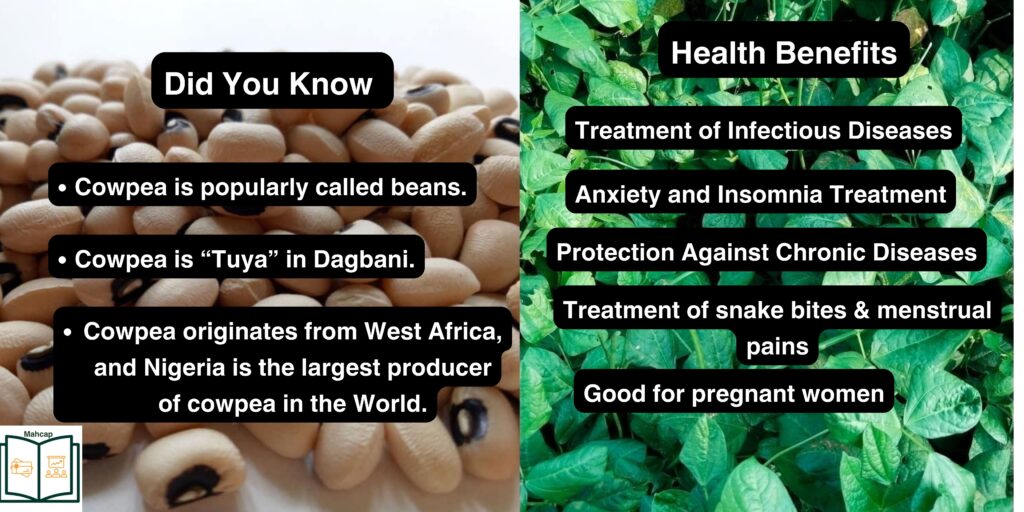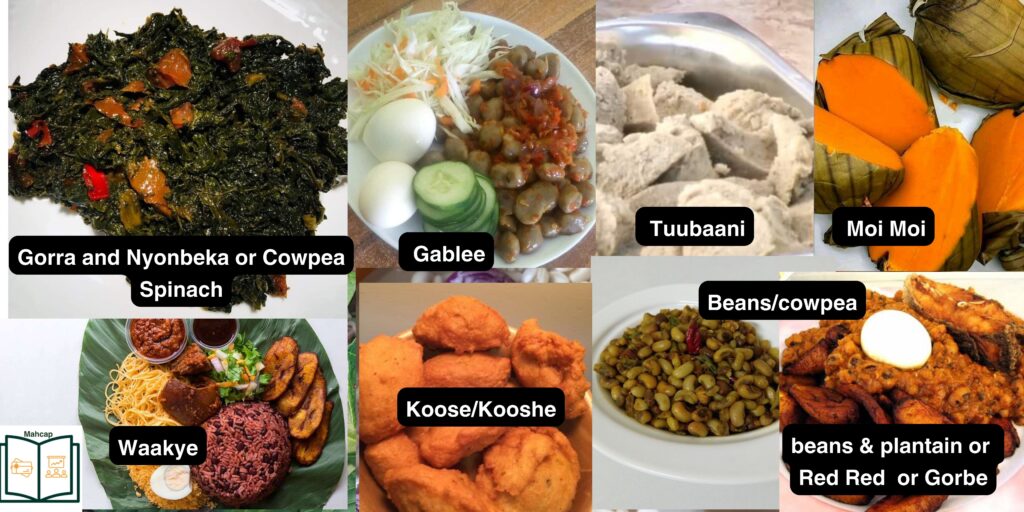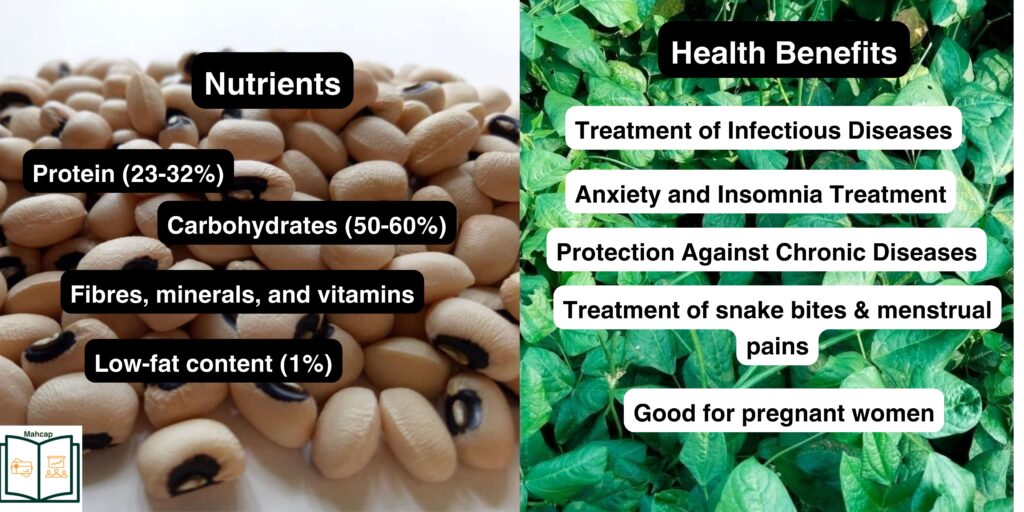Cowpea Uses, Nutritional, and Health Benefits
This review by Mahcap on cowpeas, locally known as beans, is necessary to highlight the role of cowpea leaves and seeds in providing a significant amount of dietary protein and medicinal and nutritional value for about 194 million people in Africa. It also provides insights into the critical role of cowpeas in food security and income generation. Also, this review is essential to emphasize and clarify that cowpea is part of the family of beans and peas and is different from pigeon peas. In Ghana, specifically in the Northern Region, “cowpea (tuya)” is popularly called “aduwa (pigeon pea).” Therefore, Mahcap details cowpea uses and benefits and clarifies its misconceptions.
Cowpea Production in Africa
Cowpea is a legume of the family Fabaceae, and all varieties are grouped under the species Vigna unguiculata. Cowpeas, commonly called black-eyed peas, crowder peas, or lubia, differ in size, colour, taste, maturity and yield time. Studies found that malnutrition contributes to more than one-third of all child deaths worldwide and is associated with 54% of child deaths in developing countries1. Cowpea is regarded as a high-quality protein legume crop that can reduce the high prevalence of malnutrition.
Cowpea is a versatile and drought-tolerant crop cultivated for its edible beans and leaves. It is an indigenous multipurpose African legume that originated from West Africa. Africa contributed nearly 87% of the global cowpea harvest in 2017, with Nigeria being the largest producer in the world. Globally, an estimated 3.7 million metric tonnes of cowpeas are produced annually on about 8.7 million hectares, and Nigeria alone produces approximately 2.14 million metric tonnes2. Other countries like Niger, Burkina Faso, Mali, Senegal, and Ghana also contribute significantly to cowpea production in Africa.

Cowpea is called tuya in Dagbani and differs from pigeon pea (Aduwa). They are both legumes, but cowpea is popularly known as beans and has several varieties.
Advantages of Cowpea Cultivation
Cowpea cultivation has many advantages including3:
- It is a drought-tolerant and warm-weather crop. Cowpea tolerates sandy soil and low rainfall and, therefore, is the most widely planted native legume in Africa.
- Cowpeas are often used in crop rotation due to their ability to fix nitrogen in the soil and enhance soil fertility. As a legume, cowpeas form symbiotic relationships with nitrogen-fixing bacteria, benefiting both the plant and the soil.
- Also, it is shade tolerant and, therefore, compatible as an inter-crop with maize, millet, sorghum, sugarcane and cotton.
- Cowpeas’ quick growth and rapid ground cover check soil erosion. It also has weeds suppression ability.
- Cowpeas play a crucial role in food security, providing a source of affordable protein in many developing countries. The crop is also valuable for small-scale and subsistence farmers, contributing to income generation. These characteristics have made cowpeas an important component of subsistence agriculture, particularly in Africa.
Uses of Cowpea Leaf and Seed
The specific cowpea dishes in Africa include.
Gorra and Nyonbeka or Cowpea Spinach
Cowpea leaves are also used to prepare two dishes called “gorra” and “nyonbeka” in Dagbani. Growing up as kids in the Northern Region of Ghana, we enjoyed it with oil and powdered pepper. According to research, cowpea leaf produces 9 times more calories, 1.5 times more protein, 90 times more calcium and a thousand times more ascorbic acid and beta carotene than cowpea grains4.
Cowpea Porridge
The dried leaf and seed can be milled and cooked together to make porridge for human consumption and medicinal purposes. Also, the leaf or seed can be mixed with other grains to make porridge.
Beans and Gari or with Plantain
Cooked cowpea served with gari and palm oil or with fried plantain is popular in Ghana and is known as “red red” or “gorbe.” Gorbe used to be the cheapest food at the Kwame Nkrumah University of Science and Technology and students’ favourite. However, though it is still the most popular food among students, it is no longer the cheapest.

Koose/Kooshe or Cowpea fritters
Cowpea fritters, buns, or koose/kooshe are popular snacks in Ghana and popular among the Muslim community and those from the Northern part of the country. It is called Akara or bean cake in Nigeria. Koose can be made using Bambara groundnut or cowpea flour, salt, onions, pepper, and eggs if desired. They are deep-fried to golden brown, resulting in a crispy exterior and a soft, flavourful interior, and are usually eaten with Hausa Koko or porridge.
Waakye
Waakye is a delicious Ghanaian dish made by cooking beans and rice together, with a special touch of waakye leaves for its authentic appearance. It’s served with stew or shito (a spicy pepper sauce) and other toppings.
Tuubaani and Gablee or Moi Moi
Tuubaani or gablee is a well-loved dish in the northern region of Ghana. This special dish is made with either cowpea or Bambara beans flour, and cassava flour is added to gablee. Tuubaani or gablee is served with a delightful combination of fried dried sunflower seed coarse flour called Bungu and oil. Also, in Nigeria, it is cooked with palm oil and called moi moi.
Beans Soup
Also, cowpea or bean flour is mixed with water and cooked together with seasonings, vegetables, other flours, and palm oil as soups in Nigeria.
Beans Stew
Beans stew is a hearty dish made primarily from beans cooked in a tomato sauce with various natural seasonings. It is eaten with rice, among others. This dish is very popular in Nigeria.
Nutrition and Health Benefits of Cowpea
Cowpea provides essential protein(23-32%), carbohydrates (50-60%), fibres, low-fat content (1%), and minerals, and vitamins5; it is essential in achieving a balanced diet in many African countries, thereby providing a cheaper means for accessing the necessary dietary nutrients and positively influencing the well-being and health of millions of people6.
Treatment of Infectious Diseases
The whole cowpea plant treats fever, malaria, gastric discomfort, and bilharzia7.
Anxiety and Insomnia Treatment
In addition, the leaves contain amino acids in significantly higher amounts, which counters social anxiety and insomnia and improves sleep(3).
Treatment of Pains
Cowpea powdered roots with porridge are believed to treat chest pain, epilepsy, menstrual pains and infusion with the seed for amenorrhea (missed menstruation). Also, in ethnobotany, the root is prepared as an antidote against snake bite(5).

Good for Pregnant Women
Cowpea grains have substantial levels of folic acid, a critical vitamin for all people, especially pregnant women. It prevents the occurrence of neural tube defects such as spina bifida in infants8.
Protection Against Chronic Diseases
Consumption of cowpeas exerts protection effects against several chronic diseases, such as gastrointestinal disorders, cardiovascular diseases, hypercholesterolemia and obesity9. Also, cowpea has medicinal properties, including anti-diabetic, anti-cancer, anti-hyperlipidemic, anti-inflammatory, and anti-hypertensive properties. Also, cowpea aids in digestion and strengthens blood circulation10.
Aid in Weight Loss
The low glycemic index of cowpeas is attributed to the action of resistant starch and dietary fibre, which attenuate insulin responses and reduce hunger.
It is also important to note that cowpea grain contains elements which cause bloating of the stomach when consumed. However, this problem can easily be avoided by grain soaking before dehulling and heat treatment.
Subscribe to Mahcap for more insights about African crops and their nutritional and health benefits.
What new thing did you learn from the article? Share your comments with us.
By: Huzeima Mahamadu (Researcher and storyteller) and Ayisha Gunu Mohammed (Agric Biotechnology Graduate and Researcher).
Reference
- Deen, F., Visvanathan, R., Liyanage, R., & Jayathilake, C. (2019). COWPEA: AN OVERVIEW ON ITS NUTRITIONAL FACTS AND HEALTH BENEFITS. ↩︎
- Omoigui, L. O., Kamara, A. Y., Batieno, J., Iorlamen, T., Kouyate, Z., Yirzagla, J., Garba, U., & Diallo, S. (2018). Guide to cowpea production in West Africa. International Institute of Tropical Agriculture. https://biblio1.iita.org/bitstream/handle/20.500.12478/6938/U18BkOmoiguiGuideNothomDev.pdf?sequence=1 ↩︎
- Horn, L. N., & Shimelis, H. (2020). Production constraints and breeding approaches for cowpea improvement for drought-prone agroecologies in Sub-Saharan Africa. Annals of Agricultural Sciences, 65(1), 83–91. ↩︎
- Enyiukwu, D. (2018). Nutritional Significance of Cowpea Leaves for Human Consumption. 1, 001–010. https://doi.org/10.15580/GTFSN.2018.1.061818085 ↩︎
- Jimenez-Lopez, J. C. (2021). Grain and Seed Proteins Functionality. BoD – Books on Demand. ↩︎
- Kebede, E., & Bekeko, Z. (2020). Expounding the production and importance of cowpea (Vigna unguiculata (L.) Walp.) in Ethiopia. Cogent Food & Agriculture, 6(1), 1769805. https://doi.org/10.1080/23311932.2020.1769805 ↩︎
- Deen, F., Visvanathan, R., Liyanage, R., & Jayathilake, C. (2019). COWPEA: AN OVERVIEW ON ITS NUTRITIONAL FACTS AND HEALTH BENEFITS. ↩︎
- Langyintuo, A. S., Lowenberg-DeBoer, J., Faye, M., Lambert, D., Ibro, G., Moussa, B., Kergna, A., Kushwaha, S., Musa, S., & Ntoukam, G. (2003). Cowpea supply and demand in West and Central Africa. Field Crops Research, 82(2–3), 215–231. ↩︎
- Singh, B. B., Ajeigbe, H. A., Tarawali, S. A., Fernandez-Rivera, S., & Abubakar, M. (2003). Improving the production and utilization of cowpea as food and fodder. Field Crops Research, 84(1), 169–177. https://doi.org/10.1016/S0378-4290(03)00148-5 ↩︎
- Omomowo, O. I., & Babalola, O. O. (2021). Constraints and Prospects of Improving Cowpea Productivity to Ensure Food, Nutritional Security and Environmental Sustainability. Frontiers in Plant Science, 12. https://www.frontiersin.org/journals/plant-science/articles/10.3389/fpls.2021.751731 ↩︎
